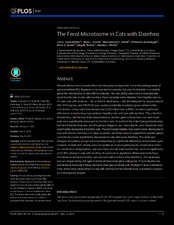| dc.creator | Suchodolski, Jan S. | |
| dc.creator | Foster, Mary L. | |
| dc.creator | Sohail, Muhammad U. | |
| dc.creator | Leutenegger, Christian | |
| dc.creator | Queen, Erica V. | |
| dc.creator | Steiner, Jörg M. | |
| dc.creator | Marks, Stanley L. | |
| dc.date.accessioned | 2015-08-31T04:11:05Z | |
| dc.date.available | 2015-08-31T04:11:05Z | |
| dc.date.issued | 2015-05-19 | |
| dc.identifier.citation | Suchodolski JS, Foster ML, Sohail MU, Leutenegger C, Queen EV, Steiner JM, et al. (2015) The Fecal Microbiome in Cats with Diarrhea. PLoS ONE 10(5): e0127378. doi:10.1371/journal.pone.0127378 | en |
| dc.identifier.uri | https://hdl.handle.net/1969.1/154851 | |
| dc.description.abstract | Recent studies have revealed that microbes play an important role in the pathogenesis of gastrointestinal (GI) diseases in various animal species, but only limited data is available about the microbiome in cats with GI disease. The aim of this study was to evaluate the fecal microbiome in cats with diarrhea. Fecal samples were obtained from healthy cats (n = 21) and cats with acute (n = 19) or chronic diarrhea (n = 29) and analyzed by sequencing of 16S rRNA genes, and PICRUSt was used to predict the functional gene content of the microbiome. Linear discriminant analysis (LDA) effect size (LEfSe) revealed significant differences in bacterial groups between healthy cats and cats with diarrhea. The order Burkholderiales, the families Enterobacteriaceae, and the genera Streptococcus and Collinsella were significantly increased in diarrheic cats. In contrast the order Campylobacterales, the family Bacteroidaceae, and the genera Megamonas, Helicobacter, and Roseburia were significantly increased in healthy cats. Phylum Bacteroidetes was significantly decreased in cats with chronic diarrhea (>21 days duration), while the class Erysipelotrichi and the genus Lactobacillus were significantly decreased in cats with acute diarrhea. The observed changes in bacterial groups were accompanied by significant differences in functional gene contents: metabolism of fatty acids, biosynthesis of glycosphingolipids, metabolism of biotin, metabolism of tryptophan, and ascorbate and aldarate metabolism, were all significantly (p<0.001) altered in cats with diarrhea. In conclusion, significant differences in the fecal microbiomes between healthy cats and cats with diarrhea were identified. This dysbiosis was accompanied by changes in bacterial functional gene categories. Future studies are warranted to evaluate if these microbial changes correlate with changes in fecal concentrations of microbial metabolites in cats with diarrhea for the identification of potential diagnostic or therapeutic targets. | en |
| dc.description.sponsorship | The open access fee for this work was funded through the Texas A&M University Open Access to Knowledge (OAK) Fund. | en |
| dc.language.iso | en_US | |
| dc.publisher | PLOS | |
| dc.rights | Attribution 3.0 United States | en |
| dc.rights.uri | http://creativecommons.org/licenses/by/3.0/us/ | |
| dc.subject | Cats | en |
| dc.subject | Diarrhea | en |
| dc.subject | Bacteria | en |
| dc.subject | Bacterial pathogens | en |
| dc.subject | Microbiome | en |
| dc.subject | Ribosomal RNA | en |
| dc.subject | Clostridium perfringens | en |
| dc.title | The Fecal Microbiome in Cats with Diarrhea | en |
| dc.type | Article | en |
| local.department | Small Animal Clinical Sciences | en |



